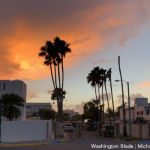Editor’s note: This past January, ASA surveyed its members about what it takes to be a leader in the field of aging, what members would like to learn about how to develop leadership knowledge, skills and abilities, and who best personifies leadership. ASA members identified respected leaders in aging—many of whom are well known to the ASA community and to the field at large. This following Q&A with Michael Adams is one in a series of leadership profiles we will feature in Aging Today and online at ASA’s AgeBlog in the coming months.
Michael Adams is the CEO of SAGE, the oldest and largest organization in the country dedicated to improving the lives of LGBTQ+ older adults. Come June, he will be celebrating a 14-year work anniversary at SAGE. An attorney by training, prior to his service at SAGE Adams worked for two LGBTQ+ legal rights organizations, Lambda Legal, as director of education and public affairs, and at the ACLU’s Lesbian & Gay Rights and AIDS Project, as associate director. Adams is a graduate of Stanford Law School and Harvard College.
This past March, Adams began his two-year tenure as ASA Board Chair. “I’m very honored to be serving as Chair of the ASA Board, and to make whatever contributions I can at this critical moment,” Adams said. “There are big shoes to fill in succeeding Karyne Jones, but I’m very excited to work in close partnership with CEO Peter Kaldes and the Board, which comprises a really wonderful group of leaders.”
AgeBlog: How might you describe the way leadership in the field of aging differs from leadership in other fields?
Michael Adams: One of the fundamental ways leadership in the field of aging differs is that its focus and orientation are so profoundly centered on human well-being. To me, that has been one of the reasons I’ve found working in this field so fulfilling—that the work is always focusing on humans, and human wellness, as we age. It’s really notable and moving to me, frankly.
AB: How did you use networking to progress in the field of aging?
MA: When I first began working in the field of aging, ASA played a very important role in my networking—and it still does. In the beginning of my tenure at SAGE, I especially appreciated attending the Aging in America Conference. Also, I quickly became involved in ASA’s LAIN Constituent Group and served on the LAIN Council in my first couple of years at SAGE. It was a wonderful experience, and a very hands-on way to work with people like me who have one foot in the LGBTQ+ world and one foot in the aging sector.
I also did different networking locally, as I am based in New York City, and had wonderful mentors who headed other organizations in aging. At that time, SAGE was struggling financially, and I had a lot to learn. I benefited markedly from mentorship in the aging field. One mentor who comes to mind is Lew Harris, a longtime Board member for LiveOn NY. He was an incredible advisor and became a great friend.
AB: What sort of education did you find most helpful?
MA: In terms of my work at SAGE, I would say that one of the most helpful things was the management work I did at organizations where I was prior to SAGE; that really helped to get me ready for working with my team at SAGE. When I first started, I had to make a lot of staff transitions due to financial troubles, and having that management experience was valuable.
It also was incredibly helpful that I took a year-long course for new nonprofit executives and directors [through Community Resource Exchange (CRE)]. That course, and what I learned there, has stayed with me. My current executive coach was one of the course instructors, and I met people, other course participants, who also were new executive directors. I have become close colleagues with those people and I still reach out to them for help and advice, all these years later.
AB: What do you think is the most critical skill to have as a leader?
MA: One of the most critical skills to have as a leader—and one that is really important right now—is the ability to maintain calm and perspective in very challenging circumstances. It is the nature of nonprofits to go through quite difficult times, and maintaining calm is critical. Also, possessing the ability to be good at recognizing what you don’t know and when to seek help in areas you don’t know are key.
AB: Can you speak to one leadership challenge encountered on the job and how you met it?
MA: One challenge is how to adapt to a rapidly growing organization and a growing body of work. That has been the case at SAGE; our work has expanded, which is tremendously wonderful for our impact and holds great benefits for our constituents, but with it comes a lot more demands, needs and requirements of leadership. Sometimes I feel stretched too thin, in trying to keep up with the organization’s growth. But I have had the opportunity to work with strong colleagues at SAGE, and to open opportunities for a number of colleagues to step into greater levels of leadership and shared responsibility. It has benefited SAGE and my personal leadership growth.
AB: What might you say to inspire younger potential leaders in the aging sector?
MA: Really embrace the gifts and opportunities that come with being in this sector. The aging sector is collegial and mutually supportive, and offers lots of opportunities to seek out and benefit from mentorships. But also you need to be ready to give back, and to help other young leaders develop. It’s often tough to think of ourselves as knowing enough to be resources, but we should always be looking out for those we can mentor and help, and be ready to give back such supports to those who don’t yet have experience.

